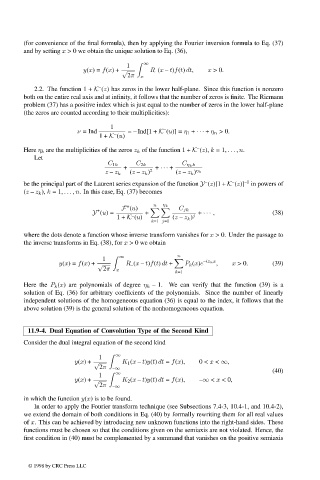Page 577 - Handbook Of Integral Equations
P. 577
(for convenience of the final formula), then by applying the Fourier inversion formula to Eq. (37)
and by setting x > 0 we obtain the unique solution to Eq. (36),
1 ∞
y(x)= f(x)+ √ R – (x – t)f(t) dt, x >0.
2π x
–
2.2. The function 1 + K (z) has zeros in the lower half-plane. Since this function is nonzero
both on the entire real axis and at infinity, it follows that the number of zeros is finite. The Riemann
problem (37) has a positive index which is just equal to the number of zeros in the lower half-plane
(the zeros are counted according to their multiplicities):
1 –
ν = Ind = – Ind[1 + K (u)] = η 1 + ··· + η n >0.
–
1+ K (u)
–
Here η k are the multiplicities of the zeros z k of the function 1 + K (z), k =1, ... , n.
Let
C 1k C 2k C η k k
+ + ··· +
η
z – z k (z – z k ) 2 (z – z k ) k
–
–1
–
be the principal part of the Laurent series expansion of the function Y (z)[1 + K (z)] in powers of
(z – z k ), k =1, ... , n. In this case, Eq. (37) becomes
n
η k
+
F (u) C jk
+
Y (u)= + + ··· , (38)
1+ K (u) (z – z k ) j
–
k=1 j=1
where the dots denote a function whose inverse transform vanishes for x > 0. Under the passage to
the inverse transforms in Eq. (38), for x > 0 we obtain
n
∞
1 –iz k x
y(x)= f(x)+ √ R – (x – t)f(t) dt + P k (x)e , x > 0. (39)
2π x k=1
Here the P k (x) are polynomials of degree η k – 1. We can verify that the function (39) is a
solution of Eq. (36) for arbitrary coefficients of the polynomials. Since the number of linearly
independent solutions of the homogeneous equation (36) is equal to the index, it follows that the
above solution (39) is the general solution of the nonhomogeneous equation.
11.9-4. Dual Equation of Convolution Type of the Second Kind
Consider the dual integral equation of the second kind
1 ∞
y(x)+ √ K 1 (x – t)y(t) dt = f(x), 0 < x < ∞,
2π –∞
1 ∞ (40)
y(x)+ √ K 2 (x – t)y(t) dt = f(x), –∞ < x <0,
2π –∞
in which the function y(x) is to be found.
In order to apply the Fourier transform technique (see Subsections 7.4-3, 10.4-1, and 10.4-2),
we extend the domain of both conditions in Eq. (40) by formally rewriting them for all real values
of x. This can be achieved by introducing new unknown functions into the right-hand sides. These
functions must be chosen so that the conditions given on the semiaxis are not violated. Hence, the
first condition in (40) must be complemented by a summand that vanishes on the positive semiaxis
© 1998 by CRC Press LLC
© 1998 by CRC Press LLC
Page 560

